Instructional Strategy Plan for Year 7 Mathematics Curriculum, Report
VerifiedAdded on 2022/12/29
|15
|3877
|2
Report
AI Summary
This report details an instructional strategy plan designed for a Year 7 mathematics curriculum, focusing on the integration of various teaching and assessment strategies. The plan outlines the context of teaching, describing the learners, the subject matter, relevant curriculum outcomes, and the objectives of the lessons. It explores two key instructional strategies: classroom teaching strategies, which encompass classroom management and differentiated instruction, and math teaching strategies involving math games and mental math. The report also analyzes two assessment strategies: analysis of student work and strategic questioning. The rationale behind these choices is explained, emphasizing how these strategies align with learning outcomes, subject matter, curriculum goals, and student characteristics. The report also highlights the benefits of cooperative learning and the importance of aligning assessment with learning outcomes. It further discusses the practical application of methods such as structured overviews, explicit teaching, and demonstrations. The report also touches upon the need for formative assessment and feedback mechanisms for improving student learning and addresses the challenges faced by teachers in implementing instructional methods and materials.
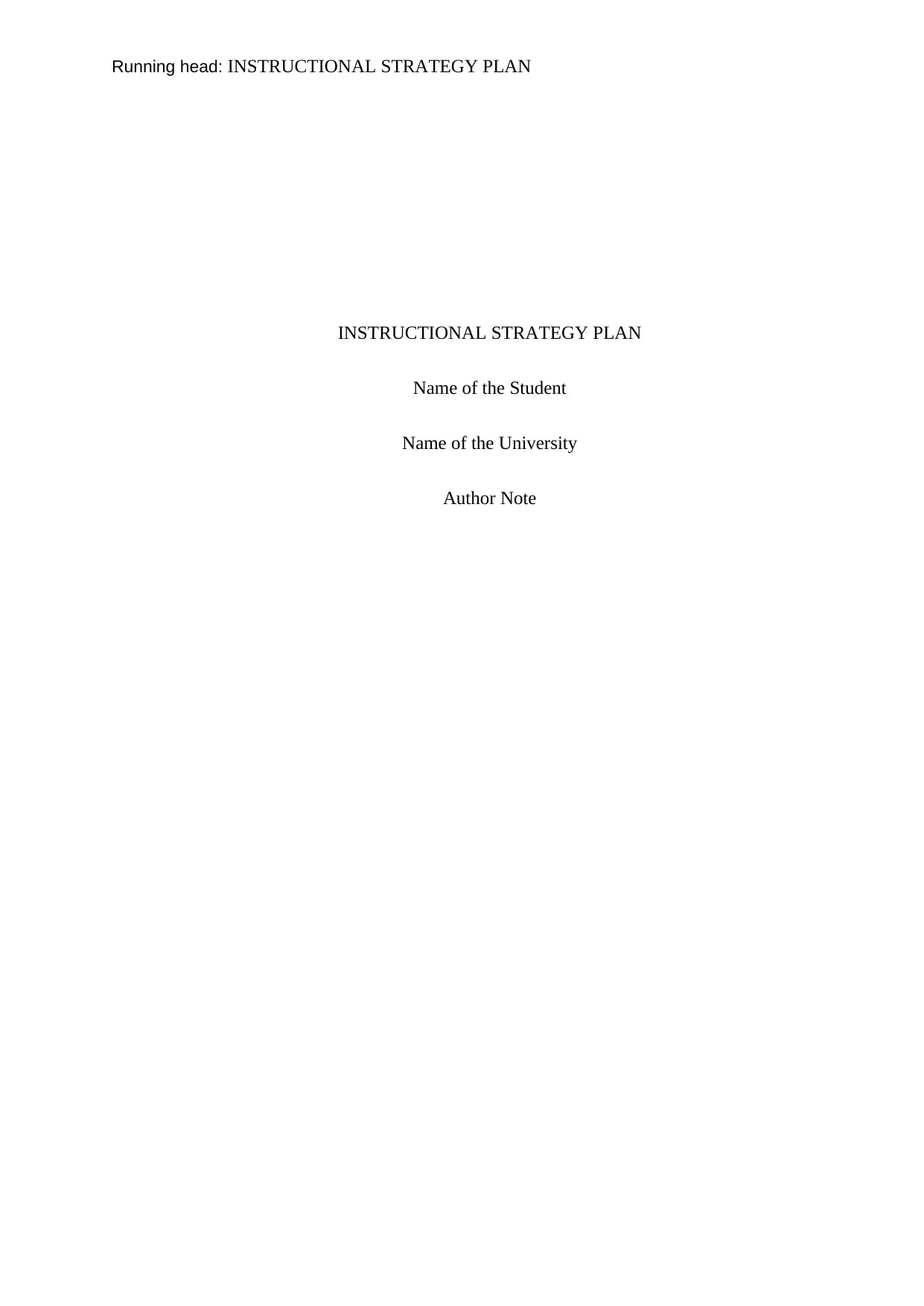
Running head: INSTRUCTIONAL STRATEGY PLAN
INSTRUCTIONAL STRATEGY PLAN
Name of the Student
Name of the University
Author Note
INSTRUCTIONAL STRATEGY PLAN
Name of the Student
Name of the University
Author Note
Paraphrase This Document
Need a fresh take? Get an instant paraphrase of this document with our AI Paraphraser
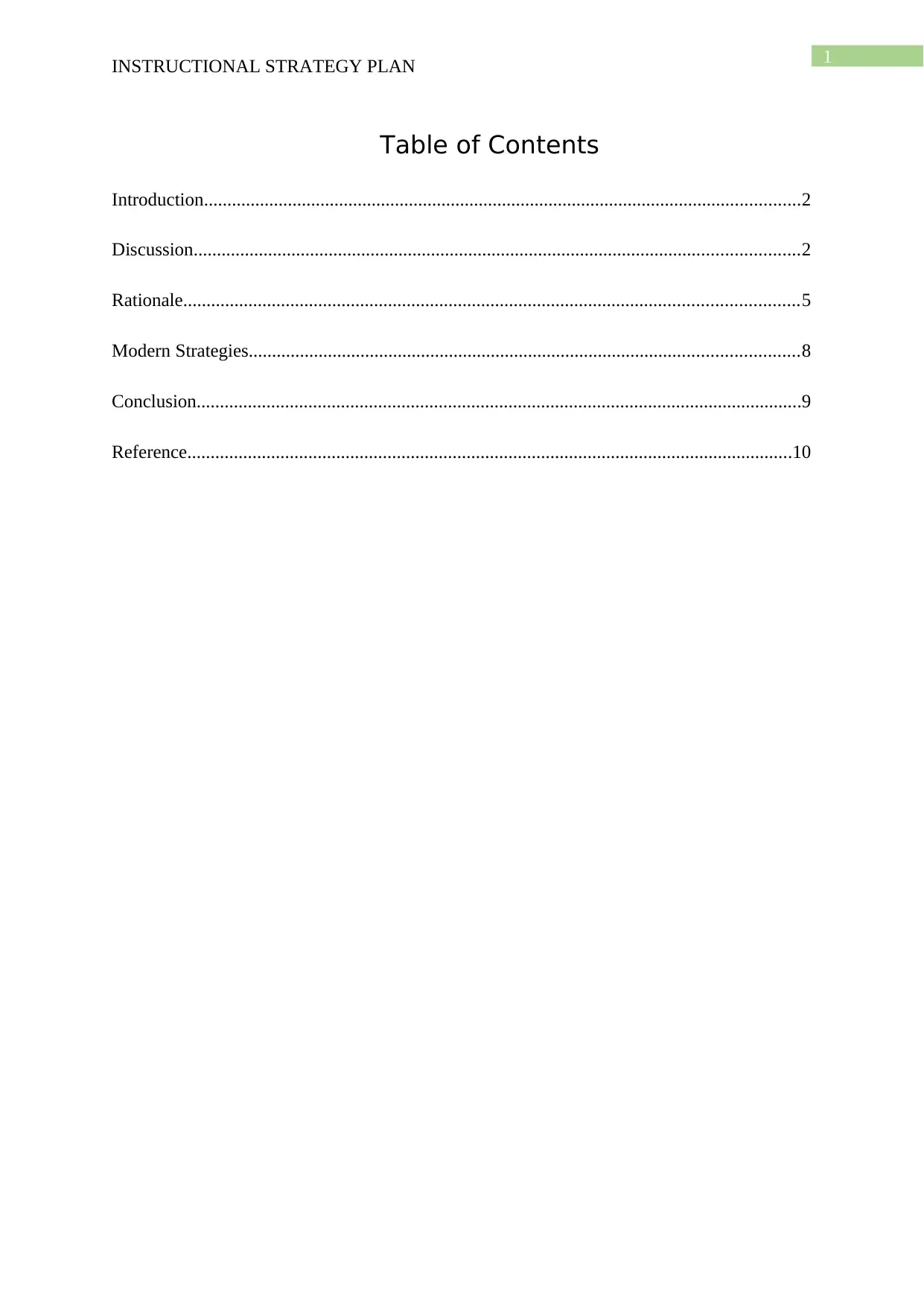
1
INSTRUCTIONAL STRATEGY PLAN
Table of Contents
Introduction................................................................................................................................2
Discussion..................................................................................................................................2
Rationale....................................................................................................................................5
Modern Strategies......................................................................................................................8
Conclusion..................................................................................................................................9
Reference..................................................................................................................................10
INSTRUCTIONAL STRATEGY PLAN
Table of Contents
Introduction................................................................................................................................2
Discussion..................................................................................................................................2
Rationale....................................................................................................................................5
Modern Strategies......................................................................................................................8
Conclusion..................................................................................................................................9
Reference..................................................................................................................................10
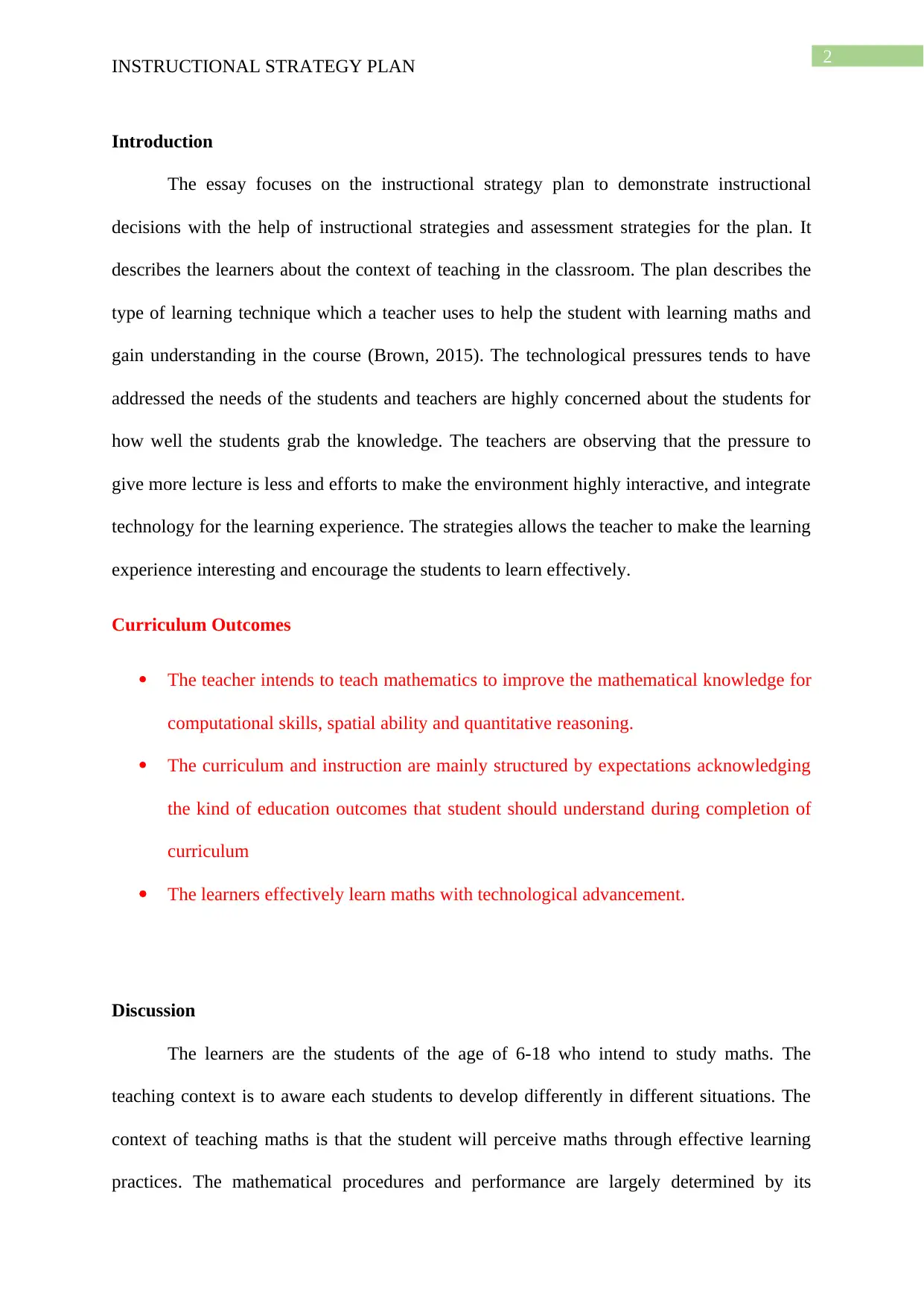
2
INSTRUCTIONAL STRATEGY PLAN
Introduction
The essay focuses on the instructional strategy plan to demonstrate instructional
decisions with the help of instructional strategies and assessment strategies for the plan. It
describes the learners about the context of teaching in the classroom. The plan describes the
type of learning technique which a teacher uses to help the student with learning maths and
gain understanding in the course (Brown, 2015). The technological pressures tends to have
addressed the needs of the students and teachers are highly concerned about the students for
how well the students grab the knowledge. The teachers are observing that the pressure to
give more lecture is less and efforts to make the environment highly interactive, and integrate
technology for the learning experience. The strategies allows the teacher to make the learning
experience interesting and encourage the students to learn effectively.
Curriculum Outcomes
The teacher intends to teach mathematics to improve the mathematical knowledge for
computational skills, spatial ability and quantitative reasoning.
The curriculum and instruction are mainly structured by expectations acknowledging
the kind of education outcomes that student should understand during completion of
curriculum
The learners effectively learn maths with technological advancement.
Discussion
The learners are the students of the age of 6-18 who intend to study maths. The
teaching context is to aware each students to develop differently in different situations. The
context of teaching maths is that the student will perceive maths through effective learning
practices. The mathematical procedures and performance are largely determined by its
INSTRUCTIONAL STRATEGY PLAN
Introduction
The essay focuses on the instructional strategy plan to demonstrate instructional
decisions with the help of instructional strategies and assessment strategies for the plan. It
describes the learners about the context of teaching in the classroom. The plan describes the
type of learning technique which a teacher uses to help the student with learning maths and
gain understanding in the course (Brown, 2015). The technological pressures tends to have
addressed the needs of the students and teachers are highly concerned about the students for
how well the students grab the knowledge. The teachers are observing that the pressure to
give more lecture is less and efforts to make the environment highly interactive, and integrate
technology for the learning experience. The strategies allows the teacher to make the learning
experience interesting and encourage the students to learn effectively.
Curriculum Outcomes
The teacher intends to teach mathematics to improve the mathematical knowledge for
computational skills, spatial ability and quantitative reasoning.
The curriculum and instruction are mainly structured by expectations acknowledging
the kind of education outcomes that student should understand during completion of
curriculum
The learners effectively learn maths with technological advancement.
Discussion
The learners are the students of the age of 6-18 who intend to study maths. The
teaching context is to aware each students to develop differently in different situations. The
context of teaching maths is that the student will perceive maths through effective learning
practices. The mathematical procedures and performance are largely determined by its
⊘ This is a preview!⊘
Do you want full access?
Subscribe today to unlock all pages.

Trusted by 1+ million students worldwide
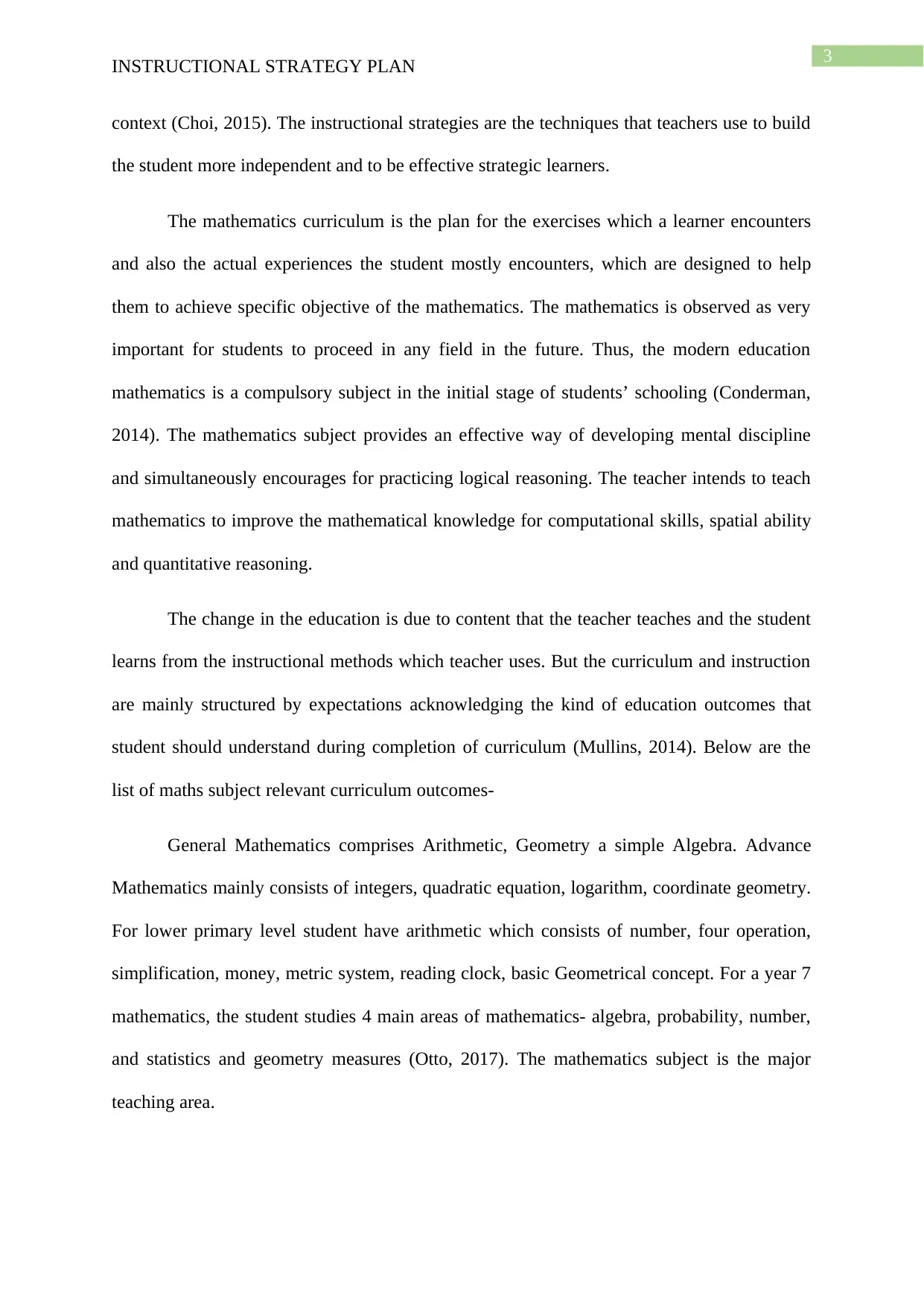
3
INSTRUCTIONAL STRATEGY PLAN
context (Choi, 2015). The instructional strategies are the techniques that teachers use to build
the student more independent and to be effective strategic learners.
The mathematics curriculum is the plan for the exercises which a learner encounters
and also the actual experiences the student mostly encounters, which are designed to help
them to achieve specific objective of the mathematics. The mathematics is observed as very
important for students to proceed in any field in the future. Thus, the modern education
mathematics is a compulsory subject in the initial stage of students’ schooling (Conderman,
2014). The mathematics subject provides an effective way of developing mental discipline
and simultaneously encourages for practicing logical reasoning. The teacher intends to teach
mathematics to improve the mathematical knowledge for computational skills, spatial ability
and quantitative reasoning.
The change in the education is due to content that the teacher teaches and the student
learns from the instructional methods which teacher uses. But the curriculum and instruction
are mainly structured by expectations acknowledging the kind of education outcomes that
student should understand during completion of curriculum (Mullins, 2014). Below are the
list of maths subject relevant curriculum outcomes-
General Mathematics comprises Arithmetic, Geometry a simple Algebra. Advance
Mathematics mainly consists of integers, quadratic equation, logarithm, coordinate geometry.
For lower primary level student have arithmetic which consists of number, four operation,
simplification, money, metric system, reading clock, basic Geometrical concept. For a year 7
mathematics, the student studies 4 main areas of mathematics- algebra, probability, number,
and statistics and geometry measures (Otto, 2017). The mathematics subject is the major
teaching area.
INSTRUCTIONAL STRATEGY PLAN
context (Choi, 2015). The instructional strategies are the techniques that teachers use to build
the student more independent and to be effective strategic learners.
The mathematics curriculum is the plan for the exercises which a learner encounters
and also the actual experiences the student mostly encounters, which are designed to help
them to achieve specific objective of the mathematics. The mathematics is observed as very
important for students to proceed in any field in the future. Thus, the modern education
mathematics is a compulsory subject in the initial stage of students’ schooling (Conderman,
2014). The mathematics subject provides an effective way of developing mental discipline
and simultaneously encourages for practicing logical reasoning. The teacher intends to teach
mathematics to improve the mathematical knowledge for computational skills, spatial ability
and quantitative reasoning.
The change in the education is due to content that the teacher teaches and the student
learns from the instructional methods which teacher uses. But the curriculum and instruction
are mainly structured by expectations acknowledging the kind of education outcomes that
student should understand during completion of curriculum (Mullins, 2014). Below are the
list of maths subject relevant curriculum outcomes-
General Mathematics comprises Arithmetic, Geometry a simple Algebra. Advance
Mathematics mainly consists of integers, quadratic equation, logarithm, coordinate geometry.
For lower primary level student have arithmetic which consists of number, four operation,
simplification, money, metric system, reading clock, basic Geometrical concept. For a year 7
mathematics, the student studies 4 main areas of mathematics- algebra, probability, number,
and statistics and geometry measures (Otto, 2017). The mathematics subject is the major
teaching area.
Paraphrase This Document
Need a fresh take? Get an instant paraphrase of this document with our AI Paraphraser
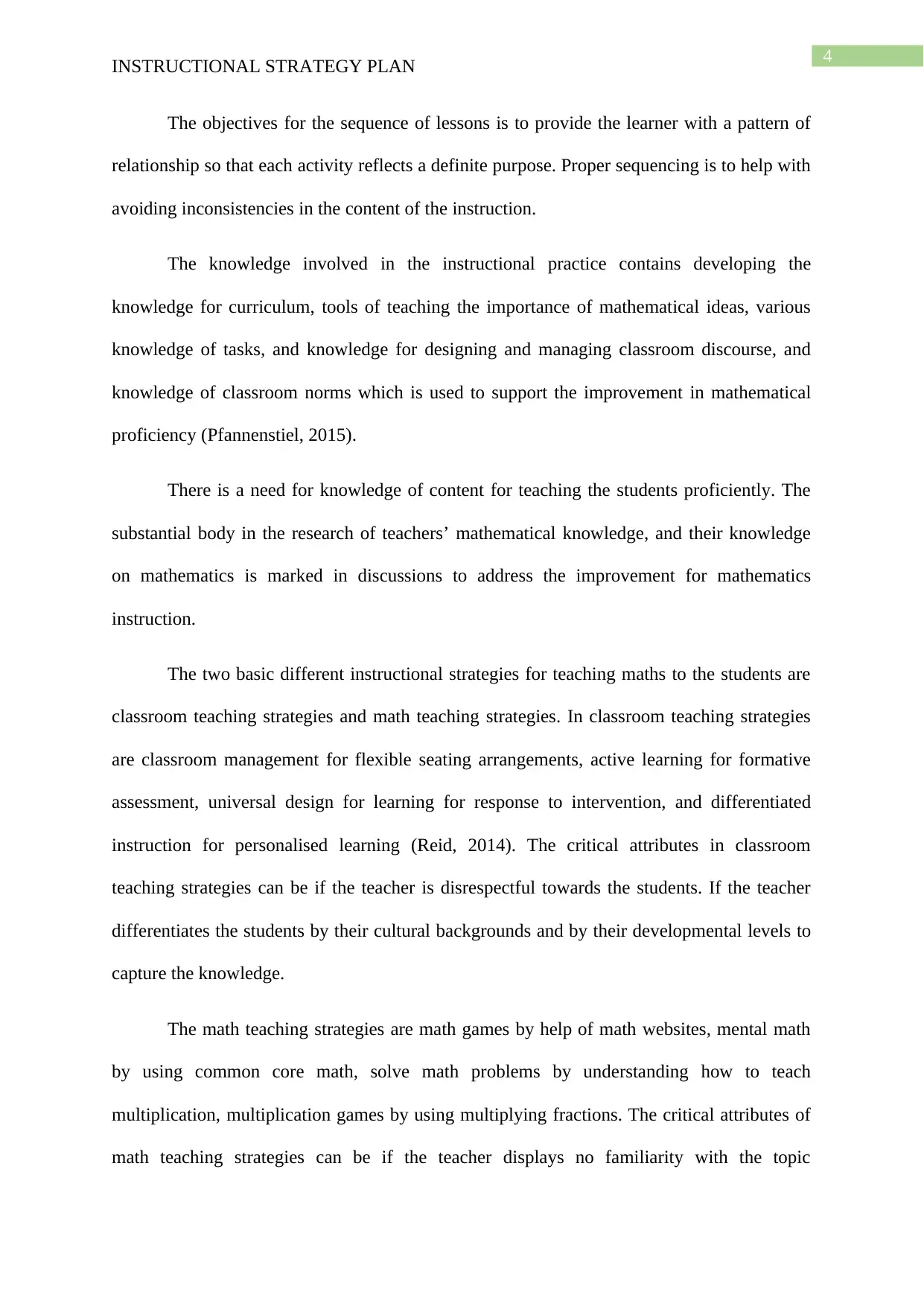
4
INSTRUCTIONAL STRATEGY PLAN
The objectives for the sequence of lessons is to provide the learner with a pattern of
relationship so that each activity reflects a definite purpose. Proper sequencing is to help with
avoiding inconsistencies in the content of the instruction.
The knowledge involved in the instructional practice contains developing the
knowledge for curriculum, tools of teaching the importance of mathematical ideas, various
knowledge of tasks, and knowledge for designing and managing classroom discourse, and
knowledge of classroom norms which is used to support the improvement in mathematical
proficiency (Pfannenstiel, 2015).
There is a need for knowledge of content for teaching the students proficiently. The
substantial body in the research of teachers’ mathematical knowledge, and their knowledge
on mathematics is marked in discussions to address the improvement for mathematics
instruction.
The two basic different instructional strategies for teaching maths to the students are
classroom teaching strategies and math teaching strategies. In classroom teaching strategies
are classroom management for flexible seating arrangements, active learning for formative
assessment, universal design for learning for response to intervention, and differentiated
instruction for personalised learning (Reid, 2014). The critical attributes in classroom
teaching strategies can be if the teacher is disrespectful towards the students. If the teacher
differentiates the students by their cultural backgrounds and by their developmental levels to
capture the knowledge.
The math teaching strategies are math games by help of math websites, mental math
by using common core math, solve math problems by understanding how to teach
multiplication, multiplication games by using multiplying fractions. The critical attributes of
math teaching strategies can be if the teacher displays no familiarity with the topic
INSTRUCTIONAL STRATEGY PLAN
The objectives for the sequence of lessons is to provide the learner with a pattern of
relationship so that each activity reflects a definite purpose. Proper sequencing is to help with
avoiding inconsistencies in the content of the instruction.
The knowledge involved in the instructional practice contains developing the
knowledge for curriculum, tools of teaching the importance of mathematical ideas, various
knowledge of tasks, and knowledge for designing and managing classroom discourse, and
knowledge of classroom norms which is used to support the improvement in mathematical
proficiency (Pfannenstiel, 2015).
There is a need for knowledge of content for teaching the students proficiently. The
substantial body in the research of teachers’ mathematical knowledge, and their knowledge
on mathematics is marked in discussions to address the improvement for mathematics
instruction.
The two basic different instructional strategies for teaching maths to the students are
classroom teaching strategies and math teaching strategies. In classroom teaching strategies
are classroom management for flexible seating arrangements, active learning for formative
assessment, universal design for learning for response to intervention, and differentiated
instruction for personalised learning (Reid, 2014). The critical attributes in classroom
teaching strategies can be if the teacher is disrespectful towards the students. If the teacher
differentiates the students by their cultural backgrounds and by their developmental levels to
capture the knowledge.
The math teaching strategies are math games by help of math websites, mental math
by using common core math, solve math problems by understanding how to teach
multiplication, multiplication games by using multiplying fractions. The critical attributes of
math teaching strategies can be if the teacher displays no familiarity with the topic
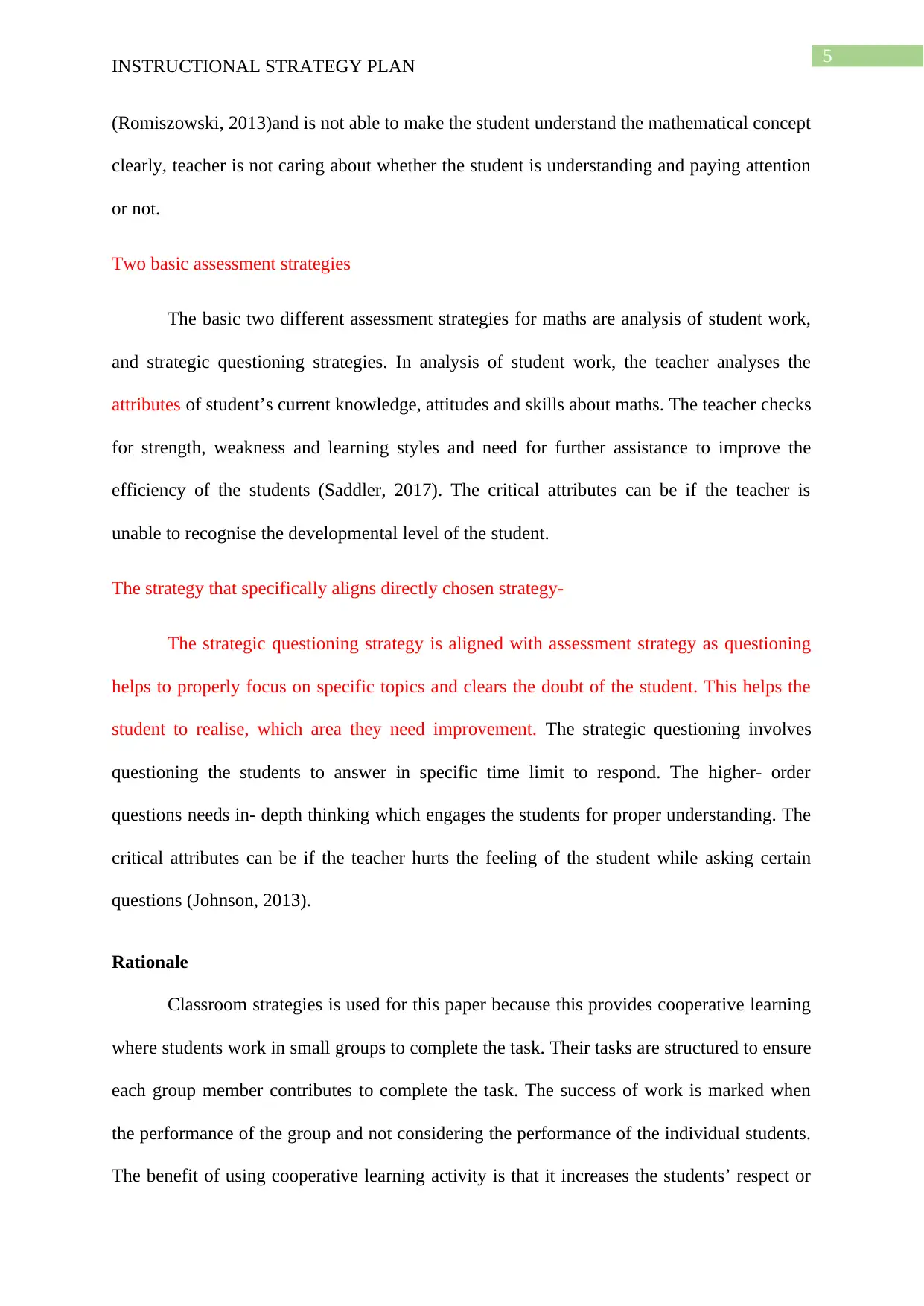
5
INSTRUCTIONAL STRATEGY PLAN
(Romiszowski, 2013)and is not able to make the student understand the mathematical concept
clearly, teacher is not caring about whether the student is understanding and paying attention
or not.
Two basic assessment strategies
The basic two different assessment strategies for maths are analysis of student work,
and strategic questioning strategies. In analysis of student work, the teacher analyses the
attributes of student’s current knowledge, attitudes and skills about maths. The teacher checks
for strength, weakness and learning styles and need for further assistance to improve the
efficiency of the students (Saddler, 2017). The critical attributes can be if the teacher is
unable to recognise the developmental level of the student.
The strategy that specifically aligns directly chosen strategy-
The strategic questioning strategy is aligned with assessment strategy as questioning
helps to properly focus on specific topics and clears the doubt of the student. This helps the
student to realise, which area they need improvement. The strategic questioning involves
questioning the students to answer in specific time limit to respond. The higher- order
questions needs in- depth thinking which engages the students for proper understanding. The
critical attributes can be if the teacher hurts the feeling of the student while asking certain
questions (Johnson, 2013).
Rationale
Classroom strategies is used for this paper because this provides cooperative learning
where students work in small groups to complete the task. Their tasks are structured to ensure
each group member contributes to complete the task. The success of work is marked when
the performance of the group and not considering the performance of the individual students.
The benefit of using cooperative learning activity is that it increases the students’ respect or
INSTRUCTIONAL STRATEGY PLAN
(Romiszowski, 2013)and is not able to make the student understand the mathematical concept
clearly, teacher is not caring about whether the student is understanding and paying attention
or not.
Two basic assessment strategies
The basic two different assessment strategies for maths are analysis of student work,
and strategic questioning strategies. In analysis of student work, the teacher analyses the
attributes of student’s current knowledge, attitudes and skills about maths. The teacher checks
for strength, weakness and learning styles and need for further assistance to improve the
efficiency of the students (Saddler, 2017). The critical attributes can be if the teacher is
unable to recognise the developmental level of the student.
The strategy that specifically aligns directly chosen strategy-
The strategic questioning strategy is aligned with assessment strategy as questioning
helps to properly focus on specific topics and clears the doubt of the student. This helps the
student to realise, which area they need improvement. The strategic questioning involves
questioning the students to answer in specific time limit to respond. The higher- order
questions needs in- depth thinking which engages the students for proper understanding. The
critical attributes can be if the teacher hurts the feeling of the student while asking certain
questions (Johnson, 2013).
Rationale
Classroom strategies is used for this paper because this provides cooperative learning
where students work in small groups to complete the task. Their tasks are structured to ensure
each group member contributes to complete the task. The success of work is marked when
the performance of the group and not considering the performance of the individual students.
The benefit of using cooperative learning activity is that it increases the students’ respect or
⊘ This is a preview!⊘
Do you want full access?
Subscribe today to unlock all pages.

Trusted by 1+ million students worldwide
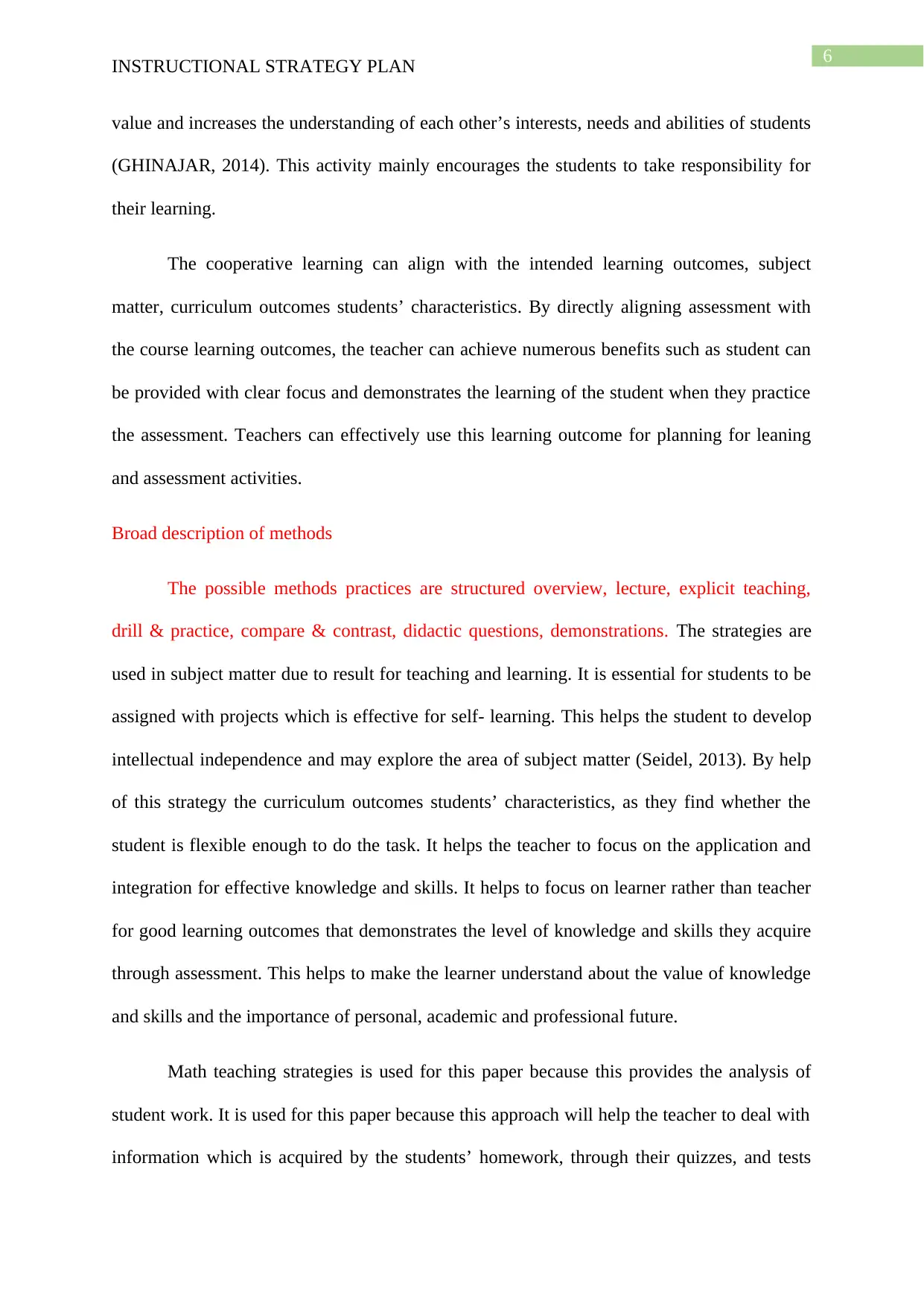
6
INSTRUCTIONAL STRATEGY PLAN
value and increases the understanding of each other’s interests, needs and abilities of students
(GHINAJAR, 2014). This activity mainly encourages the students to take responsibility for
their learning.
The cooperative learning can align with the intended learning outcomes, subject
matter, curriculum outcomes students’ characteristics. By directly aligning assessment with
the course learning outcomes, the teacher can achieve numerous benefits such as student can
be provided with clear focus and demonstrates the learning of the student when they practice
the assessment. Teachers can effectively use this learning outcome for planning for leaning
and assessment activities.
Broad description of methods
The possible methods practices are structured overview, lecture, explicit teaching,
drill & practice, compare & contrast, didactic questions, demonstrations. The strategies are
used in subject matter due to result for teaching and learning. It is essential for students to be
assigned with projects which is effective for self- learning. This helps the student to develop
intellectual independence and may explore the area of subject matter (Seidel, 2013). By help
of this strategy the curriculum outcomes students’ characteristics, as they find whether the
student is flexible enough to do the task. It helps the teacher to focus on the application and
integration for effective knowledge and skills. It helps to focus on learner rather than teacher
for good learning outcomes that demonstrates the level of knowledge and skills they acquire
through assessment. This helps to make the learner understand about the value of knowledge
and skills and the importance of personal, academic and professional future.
Math teaching strategies is used for this paper because this provides the analysis of
student work. It is used for this paper because this approach will help the teacher to deal with
information which is acquired by the students’ homework, through their quizzes, and tests
INSTRUCTIONAL STRATEGY PLAN
value and increases the understanding of each other’s interests, needs and abilities of students
(GHINAJAR, 2014). This activity mainly encourages the students to take responsibility for
their learning.
The cooperative learning can align with the intended learning outcomes, subject
matter, curriculum outcomes students’ characteristics. By directly aligning assessment with
the course learning outcomes, the teacher can achieve numerous benefits such as student can
be provided with clear focus and demonstrates the learning of the student when they practice
the assessment. Teachers can effectively use this learning outcome for planning for leaning
and assessment activities.
Broad description of methods
The possible methods practices are structured overview, lecture, explicit teaching,
drill & practice, compare & contrast, didactic questions, demonstrations. The strategies are
used in subject matter due to result for teaching and learning. It is essential for students to be
assigned with projects which is effective for self- learning. This helps the student to develop
intellectual independence and may explore the area of subject matter (Seidel, 2013). By help
of this strategy the curriculum outcomes students’ characteristics, as they find whether the
student is flexible enough to do the task. It helps the teacher to focus on the application and
integration for effective knowledge and skills. It helps to focus on learner rather than teacher
for good learning outcomes that demonstrates the level of knowledge and skills they acquire
through assessment. This helps to make the learner understand about the value of knowledge
and skills and the importance of personal, academic and professional future.
Math teaching strategies is used for this paper because this provides the analysis of
student work. It is used for this paper because this approach will help the teacher to deal with
information which is acquired by the students’ homework, through their quizzes, and tests
Paraphrase This Document
Need a fresh take? Get an instant paraphrase of this document with our AI Paraphraser
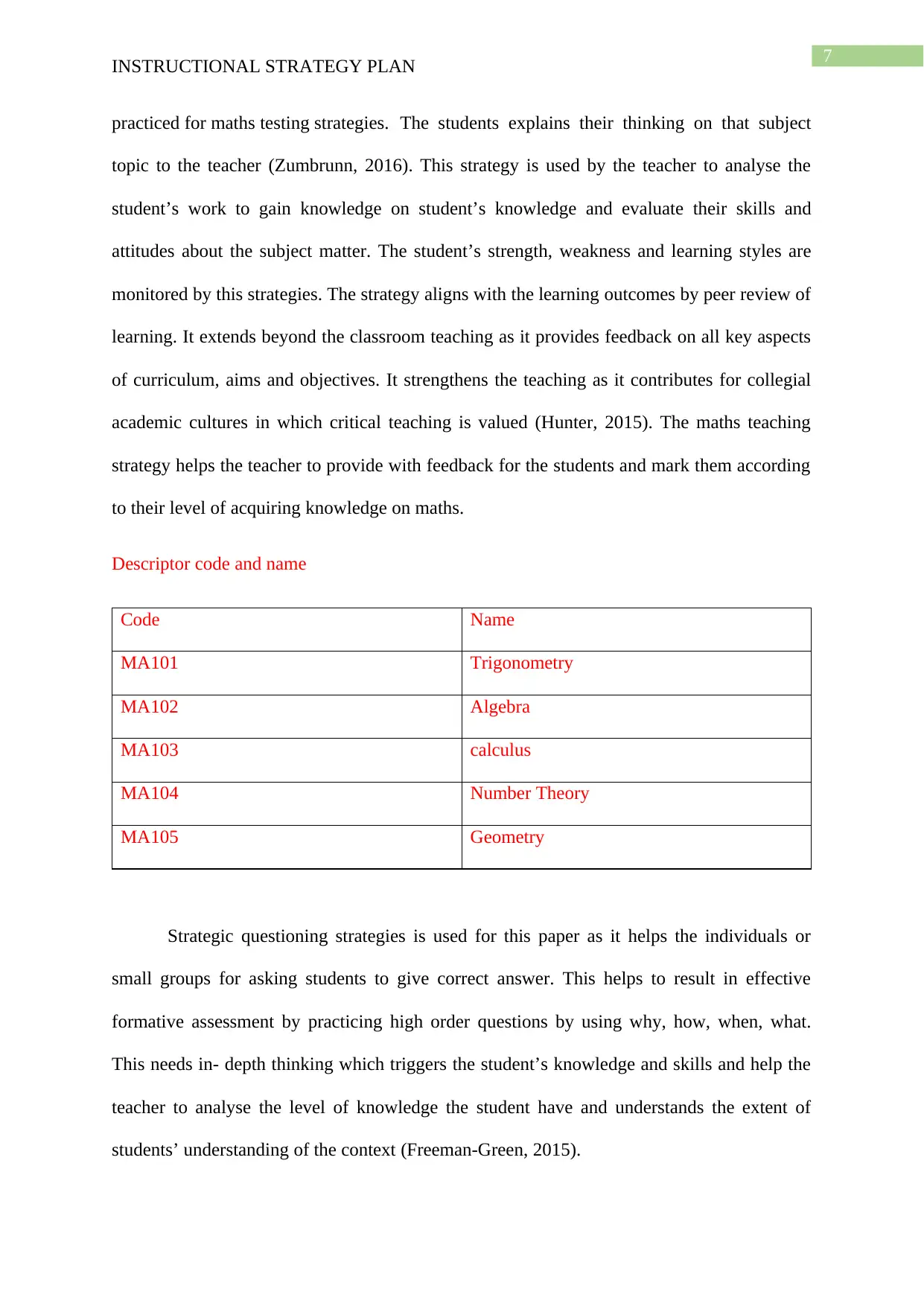
7
INSTRUCTIONAL STRATEGY PLAN
practiced for maths testing strategies. The students explains their thinking on that subject
topic to the teacher (Zumbrunn, 2016). This strategy is used by the teacher to analyse the
student’s work to gain knowledge on student’s knowledge and evaluate their skills and
attitudes about the subject matter. The student’s strength, weakness and learning styles are
monitored by this strategies. The strategy aligns with the learning outcomes by peer review of
learning. It extends beyond the classroom teaching as it provides feedback on all key aspects
of curriculum, aims and objectives. It strengthens the teaching as it contributes for collegial
academic cultures in which critical teaching is valued (Hunter, 2015). The maths teaching
strategy helps the teacher to provide with feedback for the students and mark them according
to their level of acquiring knowledge on maths.
Descriptor code and name
Code Name
MA101 Trigonometry
MA102 Algebra
MA103 calculus
MA104 Number Theory
MA105 Geometry
Strategic questioning strategies is used for this paper as it helps the individuals or
small groups for asking students to give correct answer. This helps to result in effective
formative assessment by practicing high order questions by using why, how, when, what.
This needs in- depth thinking which triggers the student’s knowledge and skills and help the
teacher to analyse the level of knowledge the student have and understands the extent of
students’ understanding of the context (Freeman‐Green, 2015).
INSTRUCTIONAL STRATEGY PLAN
practiced for maths testing strategies. The students explains their thinking on that subject
topic to the teacher (Zumbrunn, 2016). This strategy is used by the teacher to analyse the
student’s work to gain knowledge on student’s knowledge and evaluate their skills and
attitudes about the subject matter. The student’s strength, weakness and learning styles are
monitored by this strategies. The strategy aligns with the learning outcomes by peer review of
learning. It extends beyond the classroom teaching as it provides feedback on all key aspects
of curriculum, aims and objectives. It strengthens the teaching as it contributes for collegial
academic cultures in which critical teaching is valued (Hunter, 2015). The maths teaching
strategy helps the teacher to provide with feedback for the students and mark them according
to their level of acquiring knowledge on maths.
Descriptor code and name
Code Name
MA101 Trigonometry
MA102 Algebra
MA103 calculus
MA104 Number Theory
MA105 Geometry
Strategic questioning strategies is used for this paper as it helps the individuals or
small groups for asking students to give correct answer. This helps to result in effective
formative assessment by practicing high order questions by using why, how, when, what.
This needs in- depth thinking which triggers the student’s knowledge and skills and help the
teacher to analyse the level of knowledge the student have and understands the extent of
students’ understanding of the context (Freeman‐Green, 2015).
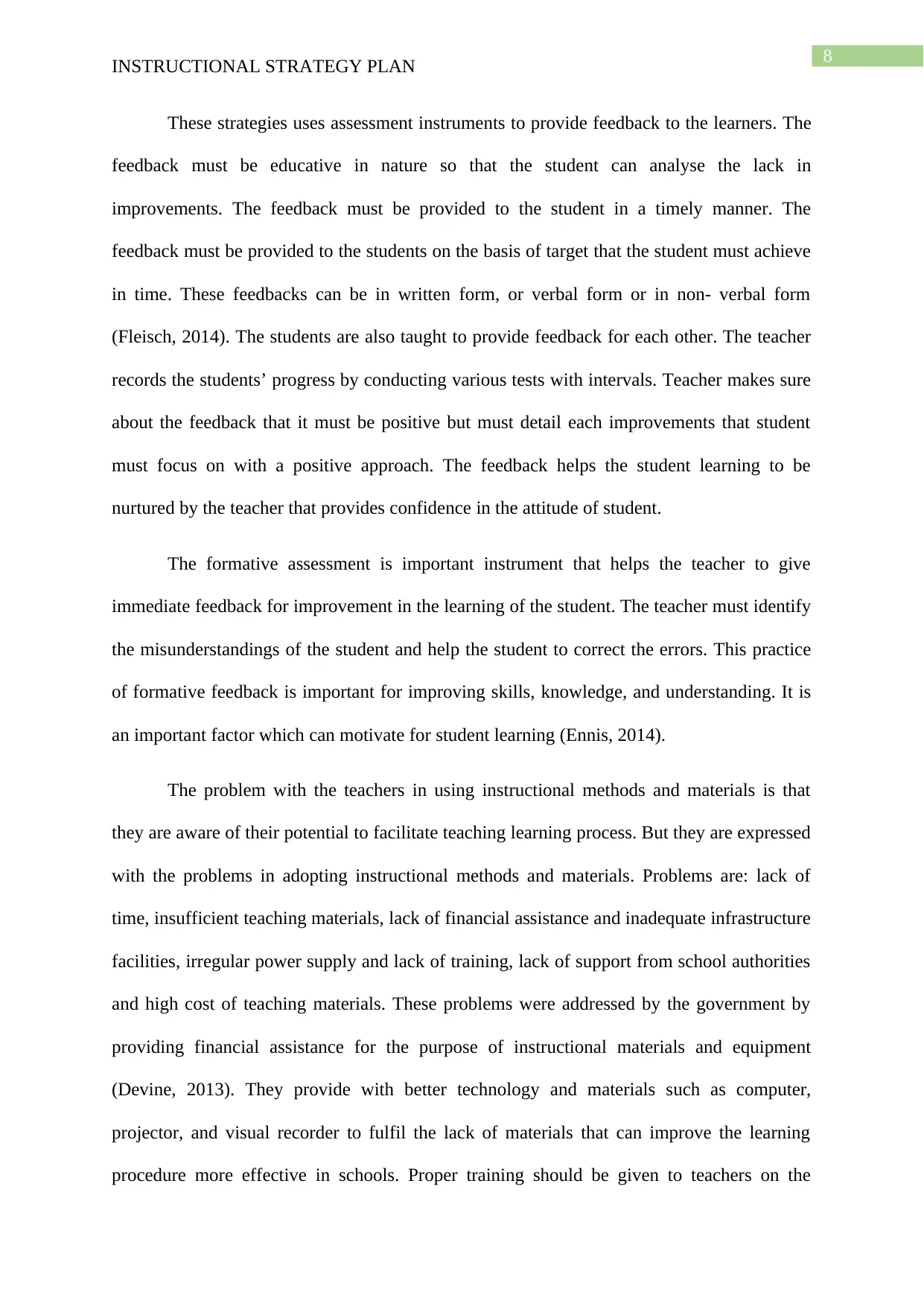
8
INSTRUCTIONAL STRATEGY PLAN
These strategies uses assessment instruments to provide feedback to the learners. The
feedback must be educative in nature so that the student can analyse the lack in
improvements. The feedback must be provided to the student in a timely manner. The
feedback must be provided to the students on the basis of target that the student must achieve
in time. These feedbacks can be in written form, or verbal form or in non- verbal form
(Fleisch, 2014). The students are also taught to provide feedback for each other. The teacher
records the students’ progress by conducting various tests with intervals. Teacher makes sure
about the feedback that it must be positive but must detail each improvements that student
must focus on with a positive approach. The feedback helps the student learning to be
nurtured by the teacher that provides confidence in the attitude of student.
The formative assessment is important instrument that helps the teacher to give
immediate feedback for improvement in the learning of the student. The teacher must identify
the misunderstandings of the student and help the student to correct the errors. This practice
of formative feedback is important for improving skills, knowledge, and understanding. It is
an important factor which can motivate for student learning (Ennis, 2014).
The problem with the teachers in using instructional methods and materials is that
they are aware of their potential to facilitate teaching learning process. But they are expressed
with the problems in adopting instructional methods and materials. Problems are: lack of
time, insufficient teaching materials, lack of financial assistance and inadequate infrastructure
facilities, irregular power supply and lack of training, lack of support from school authorities
and high cost of teaching materials. These problems were addressed by the government by
providing financial assistance for the purpose of instructional materials and equipment
(Devine, 2013). They provide with better technology and materials such as computer,
projector, and visual recorder to fulfil the lack of materials that can improve the learning
procedure more effective in schools. Proper training should be given to teachers on the
INSTRUCTIONAL STRATEGY PLAN
These strategies uses assessment instruments to provide feedback to the learners. The
feedback must be educative in nature so that the student can analyse the lack in
improvements. The feedback must be provided to the student in a timely manner. The
feedback must be provided to the students on the basis of target that the student must achieve
in time. These feedbacks can be in written form, or verbal form or in non- verbal form
(Fleisch, 2014). The students are also taught to provide feedback for each other. The teacher
records the students’ progress by conducting various tests with intervals. Teacher makes sure
about the feedback that it must be positive but must detail each improvements that student
must focus on with a positive approach. The feedback helps the student learning to be
nurtured by the teacher that provides confidence in the attitude of student.
The formative assessment is important instrument that helps the teacher to give
immediate feedback for improvement in the learning of the student. The teacher must identify
the misunderstandings of the student and help the student to correct the errors. This practice
of formative feedback is important for improving skills, knowledge, and understanding. It is
an important factor which can motivate for student learning (Ennis, 2014).
The problem with the teachers in using instructional methods and materials is that
they are aware of their potential to facilitate teaching learning process. But they are expressed
with the problems in adopting instructional methods and materials. Problems are: lack of
time, insufficient teaching materials, lack of financial assistance and inadequate infrastructure
facilities, irregular power supply and lack of training, lack of support from school authorities
and high cost of teaching materials. These problems were addressed by the government by
providing financial assistance for the purpose of instructional materials and equipment
(Devine, 2013). They provide with better technology and materials such as computer,
projector, and visual recorder to fulfil the lack of materials that can improve the learning
procedure more effective in schools. Proper training should be given to teachers on the
⊘ This is a preview!⊘
Do you want full access?
Subscribe today to unlock all pages.

Trusted by 1+ million students worldwide
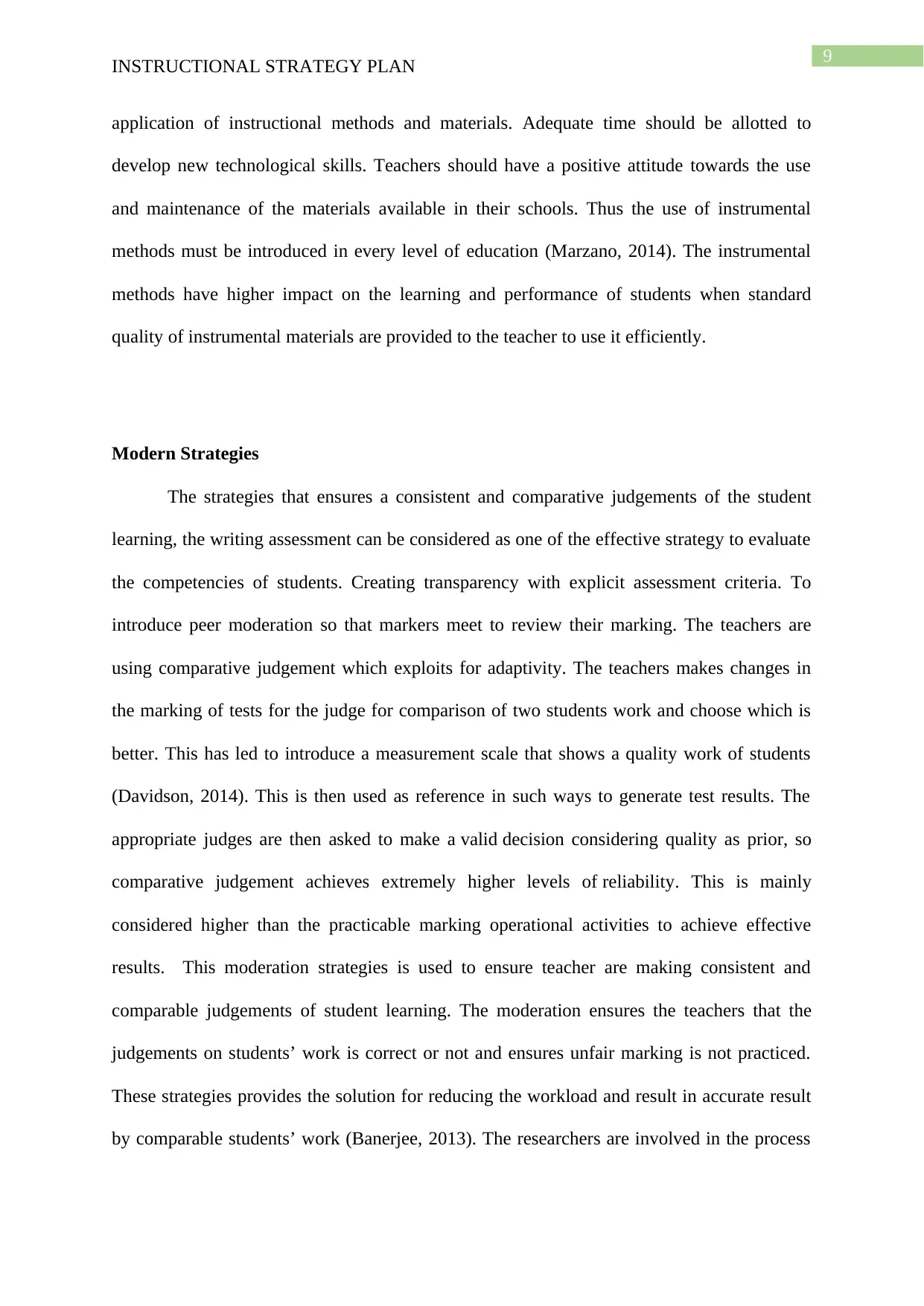
9
INSTRUCTIONAL STRATEGY PLAN
application of instructional methods and materials. Adequate time should be allotted to
develop new technological skills. Teachers should have a positive attitude towards the use
and maintenance of the materials available in their schools. Thus the use of instrumental
methods must be introduced in every level of education (Marzano, 2014). The instrumental
methods have higher impact on the learning and performance of students when standard
quality of instrumental materials are provided to the teacher to use it efficiently.
Modern Strategies
The strategies that ensures a consistent and comparative judgements of the student
learning, the writing assessment can be considered as one of the effective strategy to evaluate
the competencies of students. Creating transparency with explicit assessment criteria. To
introduce peer moderation so that markers meet to review their marking. The teachers are
using comparative judgement which exploits for adaptivity. The teachers makes changes in
the marking of tests for the judge for comparison of two students work and choose which is
better. This has led to introduce a measurement scale that shows a quality work of students
(Davidson, 2014). This is then used as reference in such ways to generate test results. The
appropriate judges are then asked to make a valid decision considering quality as prior, so
comparative judgement achieves extremely higher levels of reliability. This is mainly
considered higher than the practicable marking operational activities to achieve effective
results. This moderation strategies is used to ensure teacher are making consistent and
comparable judgements of student learning. The moderation ensures the teachers that the
judgements on students’ work is correct or not and ensures unfair marking is not practiced.
These strategies provides the solution for reducing the workload and result in accurate result
by comparable students’ work (Banerjee, 2013). The researchers are involved in the process
INSTRUCTIONAL STRATEGY PLAN
application of instructional methods and materials. Adequate time should be allotted to
develop new technological skills. Teachers should have a positive attitude towards the use
and maintenance of the materials available in their schools. Thus the use of instrumental
methods must be introduced in every level of education (Marzano, 2014). The instrumental
methods have higher impact on the learning and performance of students when standard
quality of instrumental materials are provided to the teacher to use it efficiently.
Modern Strategies
The strategies that ensures a consistent and comparative judgements of the student
learning, the writing assessment can be considered as one of the effective strategy to evaluate
the competencies of students. Creating transparency with explicit assessment criteria. To
introduce peer moderation so that markers meet to review their marking. The teachers are
using comparative judgement which exploits for adaptivity. The teachers makes changes in
the marking of tests for the judge for comparison of two students work and choose which is
better. This has led to introduce a measurement scale that shows a quality work of students
(Davidson, 2014). This is then used as reference in such ways to generate test results. The
appropriate judges are then asked to make a valid decision considering quality as prior, so
comparative judgement achieves extremely higher levels of reliability. This is mainly
considered higher than the practicable marking operational activities to achieve effective
results. This moderation strategies is used to ensure teacher are making consistent and
comparable judgements of student learning. The moderation ensures the teachers that the
judgements on students’ work is correct or not and ensures unfair marking is not practiced.
These strategies provides the solution for reducing the workload and result in accurate result
by comparable students’ work (Banerjee, 2013). The researchers are involved in the process
Paraphrase This Document
Need a fresh take? Get an instant paraphrase of this document with our AI Paraphraser
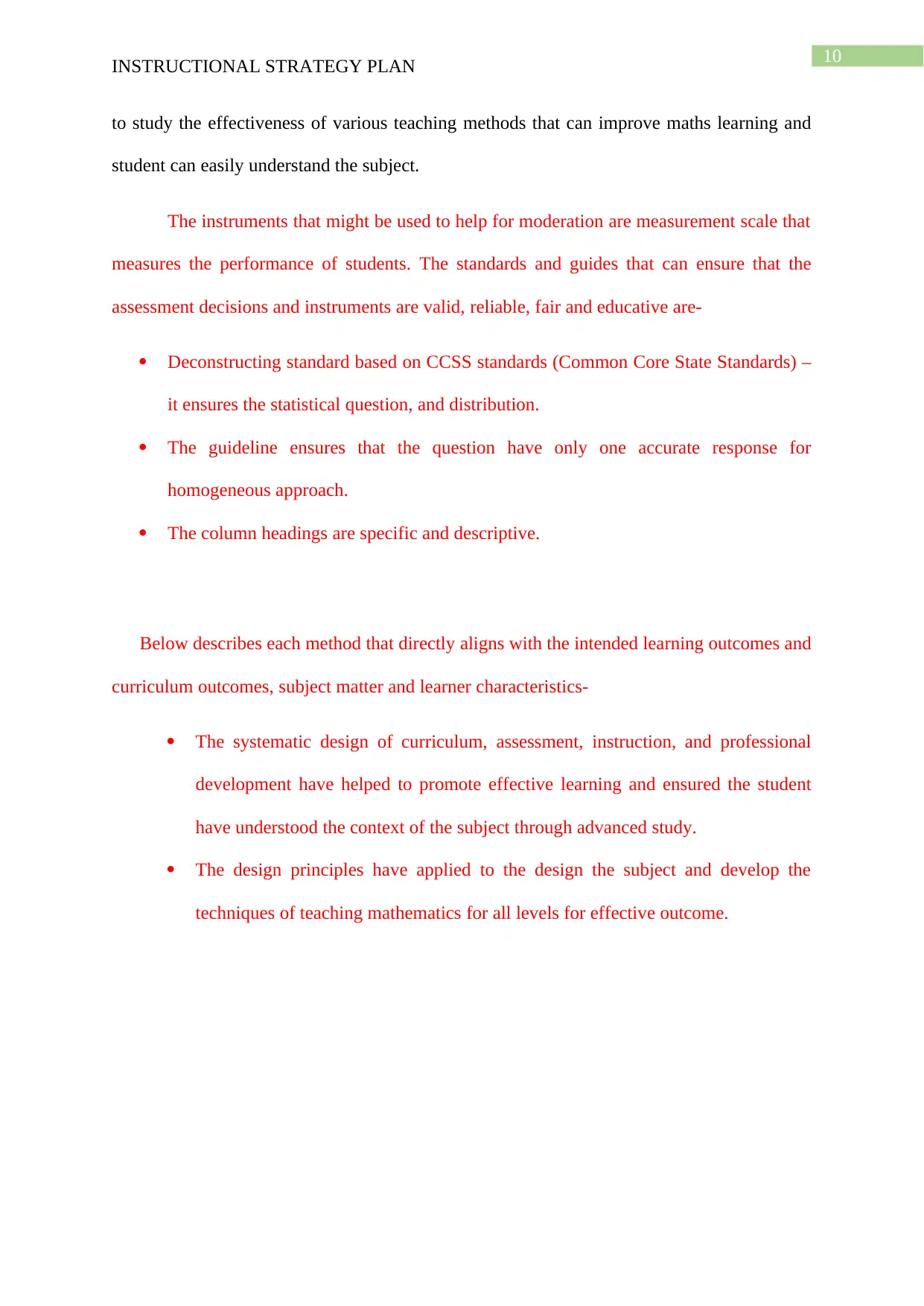
10
INSTRUCTIONAL STRATEGY PLAN
to study the effectiveness of various teaching methods that can improve maths learning and
student can easily understand the subject.
The instruments that might be used to help for moderation are measurement scale that
measures the performance of students. The standards and guides that can ensure that the
assessment decisions and instruments are valid, reliable, fair and educative are-
Deconstructing standard based on CCSS standards (Common Core State Standards) –
it ensures the statistical question, and distribution.
The guideline ensures that the question have only one accurate response for
homogeneous approach.
The column headings are specific and descriptive.
Below describes each method that directly aligns with the intended learning outcomes and
curriculum outcomes, subject matter and learner characteristics-
The systematic design of curriculum, assessment, instruction, and professional
development have helped to promote effective learning and ensured the student
have understood the context of the subject through advanced study.
The design principles have applied to the design the subject and develop the
techniques of teaching mathematics for all levels for effective outcome.
INSTRUCTIONAL STRATEGY PLAN
to study the effectiveness of various teaching methods that can improve maths learning and
student can easily understand the subject.
The instruments that might be used to help for moderation are measurement scale that
measures the performance of students. The standards and guides that can ensure that the
assessment decisions and instruments are valid, reliable, fair and educative are-
Deconstructing standard based on CCSS standards (Common Core State Standards) –
it ensures the statistical question, and distribution.
The guideline ensures that the question have only one accurate response for
homogeneous approach.
The column headings are specific and descriptive.
Below describes each method that directly aligns with the intended learning outcomes and
curriculum outcomes, subject matter and learner characteristics-
The systematic design of curriculum, assessment, instruction, and professional
development have helped to promote effective learning and ensured the student
have understood the context of the subject through advanced study.
The design principles have applied to the design the subject and develop the
techniques of teaching mathematics for all levels for effective outcome.
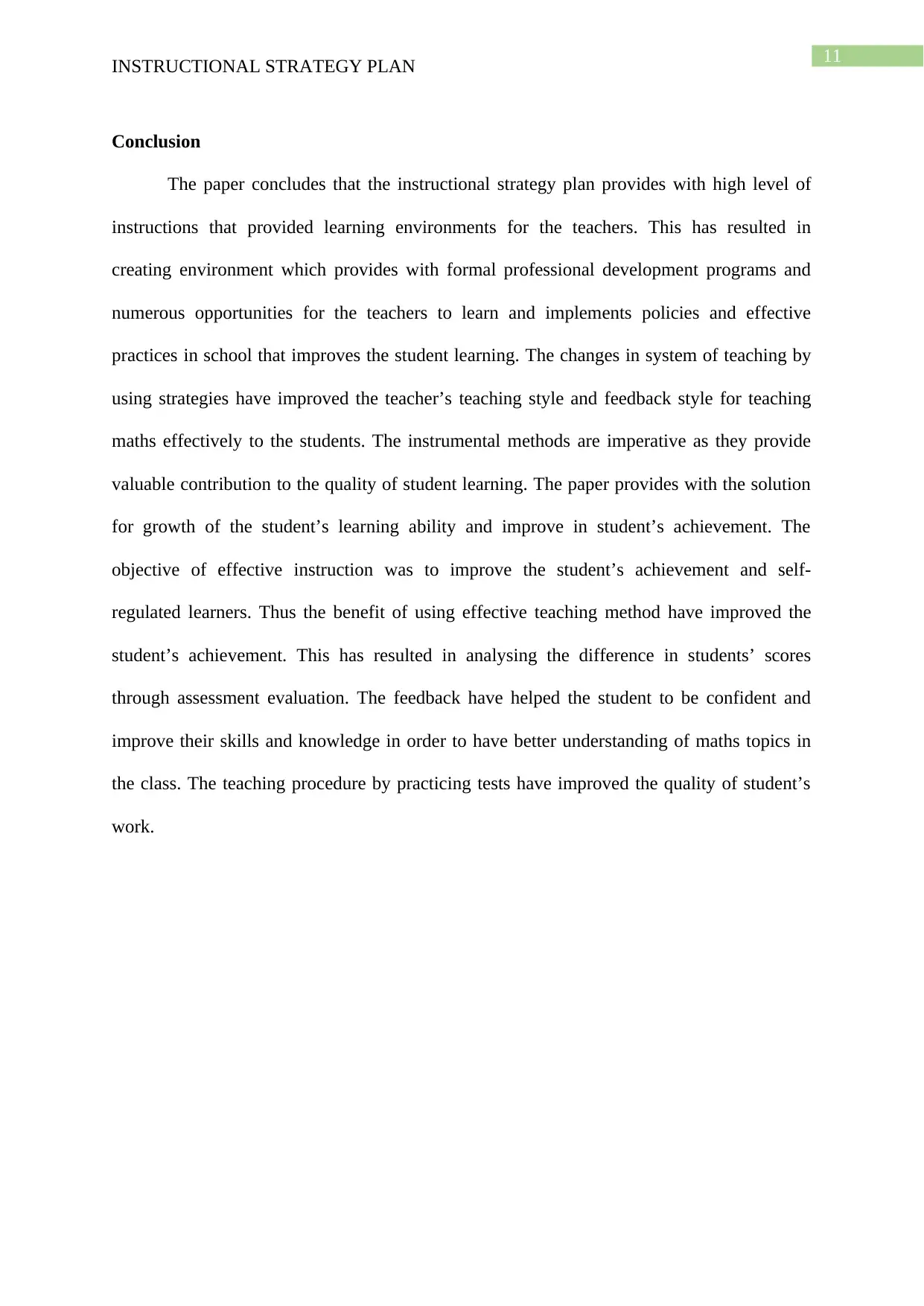
11
INSTRUCTIONAL STRATEGY PLAN
Conclusion
The paper concludes that the instructional strategy plan provides with high level of
instructions that provided learning environments for the teachers. This has resulted in
creating environment which provides with formal professional development programs and
numerous opportunities for the teachers to learn and implements policies and effective
practices in school that improves the student learning. The changes in system of teaching by
using strategies have improved the teacher’s teaching style and feedback style for teaching
maths effectively to the students. The instrumental methods are imperative as they provide
valuable contribution to the quality of student learning. The paper provides with the solution
for growth of the student’s learning ability and improve in student’s achievement. The
objective of effective instruction was to improve the student’s achievement and self-
regulated learners. Thus the benefit of using effective teaching method have improved the
student’s achievement. This has resulted in analysing the difference in students’ scores
through assessment evaluation. The feedback have helped the student to be confident and
improve their skills and knowledge in order to have better understanding of maths topics in
the class. The teaching procedure by practicing tests have improved the quality of student’s
work.
INSTRUCTIONAL STRATEGY PLAN
Conclusion
The paper concludes that the instructional strategy plan provides with high level of
instructions that provided learning environments for the teachers. This has resulted in
creating environment which provides with formal professional development programs and
numerous opportunities for the teachers to learn and implements policies and effective
practices in school that improves the student learning. The changes in system of teaching by
using strategies have improved the teacher’s teaching style and feedback style for teaching
maths effectively to the students. The instrumental methods are imperative as they provide
valuable contribution to the quality of student learning. The paper provides with the solution
for growth of the student’s learning ability and improve in student’s achievement. The
objective of effective instruction was to improve the student’s achievement and self-
regulated learners. Thus the benefit of using effective teaching method have improved the
student’s achievement. This has resulted in analysing the difference in students’ scores
through assessment evaluation. The feedback have helped the student to be confident and
improve their skills and knowledge in order to have better understanding of maths topics in
the class. The teaching procedure by practicing tests have improved the quality of student’s
work.
⊘ This is a preview!⊘
Do you want full access?
Subscribe today to unlock all pages.

Trusted by 1+ million students worldwide
1 out of 15
Related Documents
Your All-in-One AI-Powered Toolkit for Academic Success.
+13062052269
info@desklib.com
Available 24*7 on WhatsApp / Email
![[object Object]](/_next/static/media/star-bottom.7253800d.svg)
Unlock your academic potential
Copyright © 2020–2025 A2Z Services. All Rights Reserved. Developed and managed by ZUCOL.





